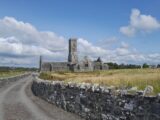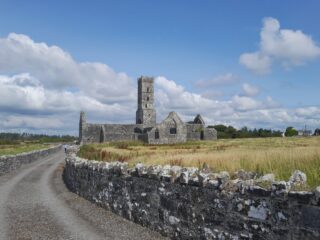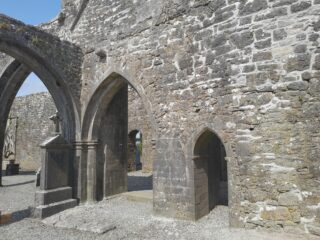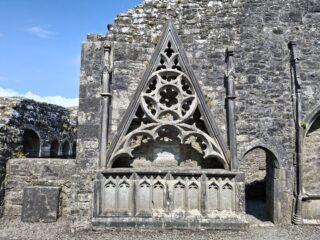Notice
Kilconnell Abbey is a state-owned National Monument in the care of the Office of Public Works
*Please be aware there are sometimes livestock in the field surrounding this monument*
WARNING: It should be noted that these sites are unguided and a level of care and caution should be maintained during all stages of your visit. The Office Of Public Works (OPW) will not be held responsible for any damages, injuries, or losses that occur
Kilconnell Franciscan Friary
Kilconnell Abbey, a Franciscan Friary, sits on the earlier monastic site of Conall. The present day Kilconnell Friary was founded in 1352 by lord of Uí Mhaine (Eastern Connaught), William Buí O’Kelly. O’Kelly’s great patronage of poets is noted in the Annals of the Four Masters. It was William Buí’s grandson, William Mór O’Kelly, who made considerable renovations to Kilconnell in the early 15th century. This is the same William, who, with his wife Anabelle Star, had a ciborium (a vessel to hold the Eucharistic host) made and dated 1409. This chalice, and many other liturgical objects, were removed from the friary for safekeeping during the 17th century. It can be seen on display at Kylemore Abbey, Galway. An inventory in 1698 shows twenty-six chalices at Kilconnell. William Mór died in 1420 and was buried in Kilconnell. Further renovations came in the mid-15th century with the addition of a tower, south aisle and transept, works commissioned by Malachy O’Kelly. It was Malachy who introduced the Observant reform (Order of Friars Minor) to the friary.
Sir Richard Bingham, lord President of Connaught, took Kilconnell in the 1580’s, and used it as a garrison, to quell the Connaught rebellion during his first term. However, the friary was not damaged and the friars remained in situ, on command of Bingham, to preserve the friary.
By 1617 Kilconnell Abbey consisted of a friary, a chapel, library, twenty-eight dormitories and other buildings. The abbey also had four gardens, three orchards, one mill and water course, four acres of land and a cemetery. After the Bishops’ Banishment Act of 1697, the friars left the friary but remained in the area until 1801.
Presently, the site contains a nave and chancel church with a south aisle and transept with a three-storey slim tower, domestic ranges and a partial cloister. Entry is via the west side doorway, with the area within lit by several traceried windows. In the nave, one of several elaborately carved canopied tomb-niches is found. Two figures are carved into stone above the canopy, one is believed to be St. Francis. The six stone carved figures at the base are (from left): St. John the Evangelist, St. Louis of Toulouse, The Virgin Mary, St. John the Baptist, St. James of Compostela and St. Denis of Paris. The south transept has two tomb niches. The chapel, known as O’Donellan chapel, opens off the transept. The chancel, lit by a four-light window, has the wall tomb of the Daly family.
Protect our Past - Click here to read about the importance of protecting our country’s unique heritage sites
This national monument is protected in accordance with the National Monuments Acts 1930 to 2014
Gallery
Nearby sites to visit
Athenry Castle
An emblem of Norman lordship
Approx. 23.1 km from Kilconnell Franciscan Friary
Clonmacnoise Monastic Site
A spectacular monastery on the banks of the river Shannon
Approx. 27.6 km from Kilconnell Franciscan Friary
Portumna Castle and Gardens
Seventeenth-century splendour on the shores of Lough Derg
Approx. 29.9 km from Kilconnell Franciscan Friary
Roscommon Castle-South West Tower
A dramatic and imposing thirteenth Century Norman Castle
Approx. 36.2 km from Kilconnell Franciscan Friary
Corlea Iron Age Roadway and Visitor Centre
A pathway into the past
Approx. 48.2 km from Kilconnell Franciscan Friary
Rathcroghan Visitor Centre
Follow in the footsteps of Queen Medb at Connacht’s ancient capital
Approx. 50.6 km from Kilconnell Franciscan Friary




